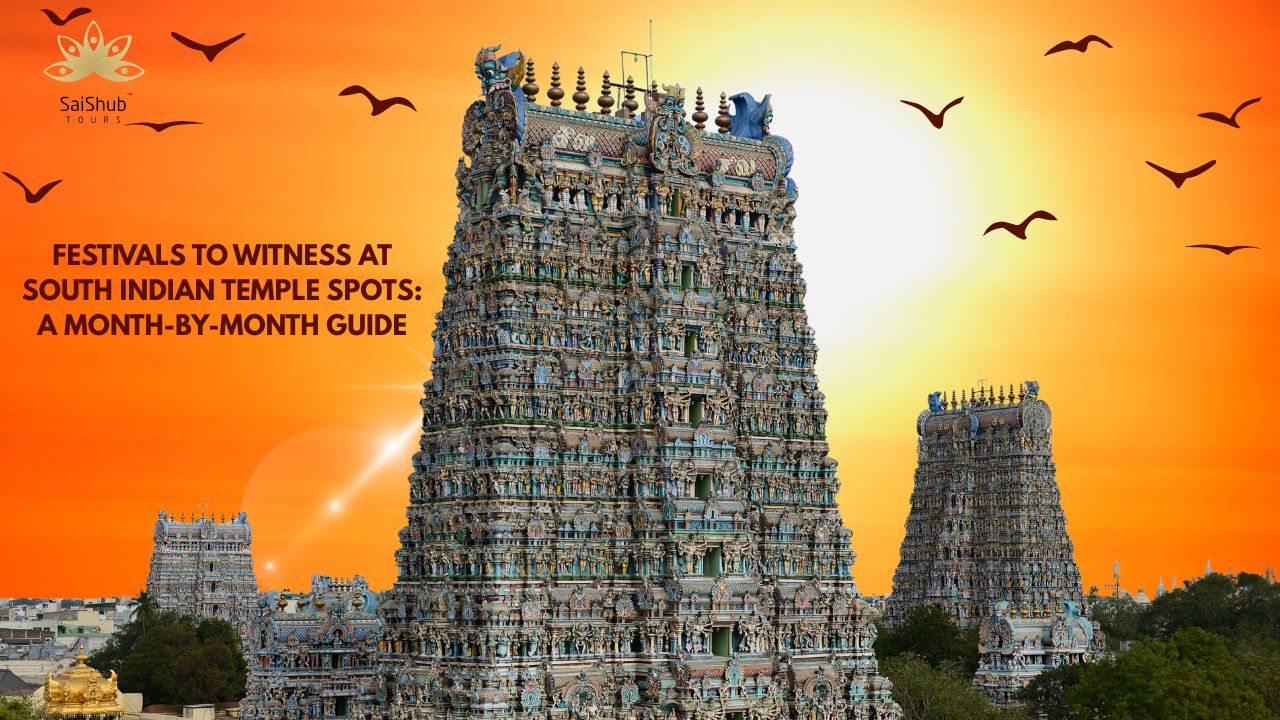
South India is home to some of the most magnificent temples in the world, each with a rich history, stunning architecture, and vibrant cultural traditions. What makes these temples even more captivating are the festivals celebrated throughout the year. These events are not just religious occasions but also cultural extravaganzas that attract devotees and tourists from across India and the world.
If you are planning a pilgrimage, here’s a month-by-month guide to festivals at South Indian temple spots that you must witness.
January – Pongal at Madurai Meenakshi Temple
Pongal is the harvest festival celebrated with great fervor in Tamil Nadu. The Meenakshi Amman Temple is beautifully decorated, and devotees participate in special poojas and processions.
February – Arudra Darshan at Chidambaram
This festival celebrates Lord Nataraja, the cosmic dancer. Devotees gather at the Chidambaram Nataraja Temple to witness grand abhishekam and cultural performances.
March – Maha Shivaratri at Thanjavur Brihadeeswara Temple
Maha Shivaratri is celebrated with night-long vigils, prayers, and special rituals. The Brihadeeswara Temple, a UNESCO heritage site, hosts devotees for spiritual gatherings.
April – Tamil New Year at Kanchipuram Temples
Kanchipuram, the city of a thousand temples, celebrates Tamil New Year with temple decorations, rituals, and cultural programs. Silk sarees and handicrafts are in full display at local markets.
May – Rathotsavam at Udupi Krishna Temple
The famous chariot festival (Rathotsavam) in Udupi attracts thousands. Devotees pull the giant chariot of Lord Krishna, accompanied by traditional music and festive cheer.
June – Pavitrotsavam at Tirupati Venkateswara Temple
This annual festival involves elaborate rituals to cleanse and protect the temple and devotees. Special poojas and music performances mark the occasion.
July – Guru Purnima at Sringeri Sharada Peetham
Devotees honor spiritual teachers at Sringeri, one of the oldest mathas in South India. Discourses, prayers, and rituals are conducted throughout the day.
August – Krishna Janmashtami at Udupi and Guruvayur
Celebrating the birth of Lord Krishna, devotees engage in fasting, devotional songs, and midnight poojas. Udupi and Guruvayur temples are especially lively during this time.
September – Navaratri at Chamundeshwari Temple, Mysore
Navaratri celebrations feature elaborate decorations, processions, and cultural programs. The Chamundeshwari Temple atop Chamundi Hill becomes a focal point for devotees.
October – Vijayadashami at Chamundeshwari and Kanchipuram
The culmination of Navaratri, Vijayadashami is celebrated with rituals, processions, and festive fairs. Devotees witness vibrant celebrations and cultural events.
November – Deepavali at Tirupati and Madurai
The festival of lights sees temples adorned with lamps, colorful rangoli, and fireworks. Devotees participate in special poojas and distribute prasadam.
December – Hanuman Jayanti at Various South Indian Temples
Devotees celebrate Lord Hanuman’s birth with special prayers, chanting, and processions in temples across Karnataka, Tamil Nadu, and Andhra Pradesh.
Why Experiencing Temple Festivals is Special
Festivals showcase South India’s rich culture, music, and dance traditions.
You can witness grand rituals, processions, and temple decorations unique to each temple.
Participating in festivals enhances your spiritual connection and understanding of local traditions.
FAQ
Some of the most famous festivals include Pongal at Madurai, Arudra Darshan at Chidambaram, Krishna Janmashtami at Udupi, and Navaratri at Chamundeshwari Temple.
Each temple has its unique festival calendar. Planning your visit around major festivals like Pongal, Navaratri, or Krishna Janmashtami ensures a vibrant experience.
Yes, most temple festivals are open to all devotees and tourists. You can witness rituals, processions, and cultural events, though some inner sanctum rituals may be restricted.
It’s recommended to dress modestly, follow temple etiquette, and plan travel in advance due to large crowds during festival periods.
These festivals combine devotion, art, culture, and music. Processions, lamp ceremonies, and temple decorations create a unique spiritual and cultural experience.
Conclusion
Planning your South Indian temple pilgrimage around festival dates can be a life-changing experience. Each festival adds a unique charm to the temple, creating memories that go beyond spiritual darshan. Make sure to check the local temple calendars and include these celebrations in your travel itinerary for an immersive journey into devotion, culture, and tradition.

